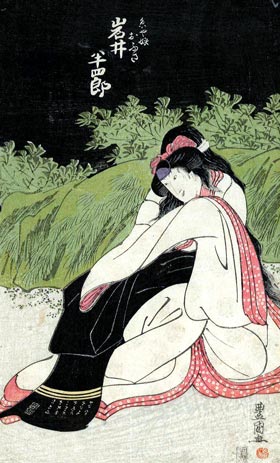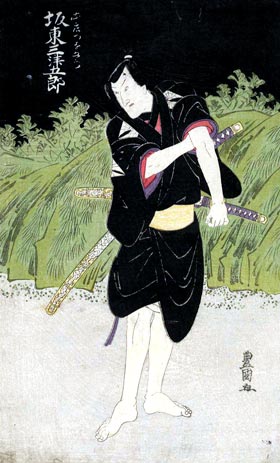| ITOYA NO MUSUME |
| Play title | Kokoro no Nazo Toketa Iroito |
| Authors | Katsu Hy˘z˘ I Sakurada Jisuke II |
| History |
Katsu Hy˘z˘ I and Sakurada Jisuke II drama "Kokoro no Nazo Toketa Iroito" was premiered in the 1st lunar month of 1810 at the Ichimuraza [casting]. This drama is also entitled "Honch˘ Itoya no Musume" (lit., the Daughter of the Thread Shop in the District of Honch˘). It mixes three different love stories, one of them being a koito-sashichimono (the love story of the courtesan Koito and the fireman Sashichi). |
| Structure |
The original drama was in 5 acts. The great revival of "Kokoro no Nazo Toketa Iroito" in June 1973 at the National Theatre (more details) was made up of 5 acts divided into 13 scenes. |
| Key words |
Itoya Kizewamono Koito-sashichimono Sewamono |
| Summary |
This summary focuses on the Tsunagor˘-Ofusa love story, one of the three love stories within "Kokoro no Nazo Toketa Iroito". The play centers around a thread shop kept by a widow named Oritsu, who has a beautiful young daughter, Ochiyo. The head clerk, or bant˘, of the shop is a villain called Sagobŕ. Ochiyo has already bestowed her affections on a r˘nin, Honj˘ Tsunagor˘. The mother, not in the secret of her daughter's love affair, settles upon one Kanbara Sagor˘, and in spite of Ochiyo's unwillingness to accept this man as husband the mother went forward with the preparations for the marriage. The scheming bant˘, who sees the pretty daughter as well as the prosperous thread business slipping out of his grasp, resorts to desperate measures, and consults his confidential friend, a doctor called T˘rin. From him a quantity of poison is secured, but it possesses peculiar qualities, for like Juliet's potion it produced sham death, and an antidote is to be administered that would bring Ochiyo back to life. The bant˘ receives the deadly poison, and the doctor is just about to hand over the antidote when Sagobŕ is called away. At the same time the doctor receives an urgent call to see a patient. There is nothing left for him to do but to trust the antidote to the little apprenticeboy of the shop. This worthy goes out to buy some pepper to be used in the soup at the marriage feast. When he returns, the boy gives the wicked Sagobŕ the pepper instead of the antidote, and as the condiment is opened in the dark both Sagobŕ and the boy sneeze a good deal. Then comes that moment in a Japanese wedding when the bride and bridegroom drink sake from the same cup. One sip of the poisoned sake and Ochiyo falls dead. The stage then revolves, showing the kitchen and the sorrowful mother holding an argument with Sagobŕ as to the disposition of the one hundred ry˘ that was part of Ochiyo's dowry. The mother wishes to present it to a temple, but the clerk insists it should be buried with her. Ochiyo's lover next appears--discharged from service under his feudal lord because he had been implicated in the loss of a highly treasured poem in the handwriting of the poet. This had been pawned, and in order to redeem it he is obliged to find 250 ry˘. The apprentice-boy throws away the antidote, thinking it is pepper and therefore of no further use now that a calamity had overtaken the house. Tsunagor˘ picks it up, and the boy tells him that 100 ry˘ is to be buried with the body. A night watchman happens to overhear the boy's words, and plans to rob the grave. Tsunagor˘ in desperate need of money decides on the same course. Both the doctor and the clerk have a similar end in view. A graveyard is the next scene, Ochiyo's coffin in sight, while a dead patient has been interred, with Ochiyo's name placed over it. Tsunagor˘ watches, and when the doctor comes prowling about, knocks him out with a blow. At this moment Ochiyo begins to groan. Tsunagor˘ wishes to give her the antidote but hesitates. Is it to be the money or the woman? After a struggle, he decides he cannot leave Ochiyo to die, and so brings her back to life. She gladly parts with the money, but asks him to run away with her, as she does not wish to return home. This the r˘nin is in no mood to do, but finally they steal away arm in arm as the night watchman and the clerk attempt to rob the grave, and administer the pepper to restore the corpse to life which makes the two rascals sneeze prodigiously. Unlike the majority of Japanese plays that end in tragedy, Tsunagor˘ and Ochiyo are married and live happily ever after. Source: ZoŰ Kincaid in "Kabuki, the Popular Stage of Japan" (edited by Sh˘riya Aragor˘) |
| Trivia |
"In an article contributed to a theatre magazine, Ihara Seiseiin tells how he
discovered the plot of "Romeo and Juliet" in a comedy by Tsuruya Nanboku,
that indefatigable seeker after weird material for his plays. The coincidence is
attributed to the fact that at the time the play was written, during Bunka (1804-1817),
the Dutch were in Nagasaki and may have produced the play, a report of which eventually reached Tsuruya Nanboku's ears.
This work, says Ihara, was a comedy rather than a tragedy, and it was called by the fanciful title, "Kokoro no Nazo Tokete Iroito" (lit., The Solution of the Heart Riddle Coloured Thread)." |
 |
 |
|
The actors Iwai Hanshir˘ V and Band˘ Mitsugor˘ III playing the roles of Ofusa and Honj˘ Tsunagor˘ in the drama "Kokoro no Nazo Toketa Iroito", which was staged in the 1st lunar month of 1810 at the Ichimuraza (print made by Utagawa Toyokuni I) |
|
|
|
| Contact | Main | Top | Updates | Actors | Plays | Playwrights | Programs | Links | FAQ | Glossary | Chronology | Illustrations | Prints | Characters | Derivatives | Theaters | Coming soon | News |